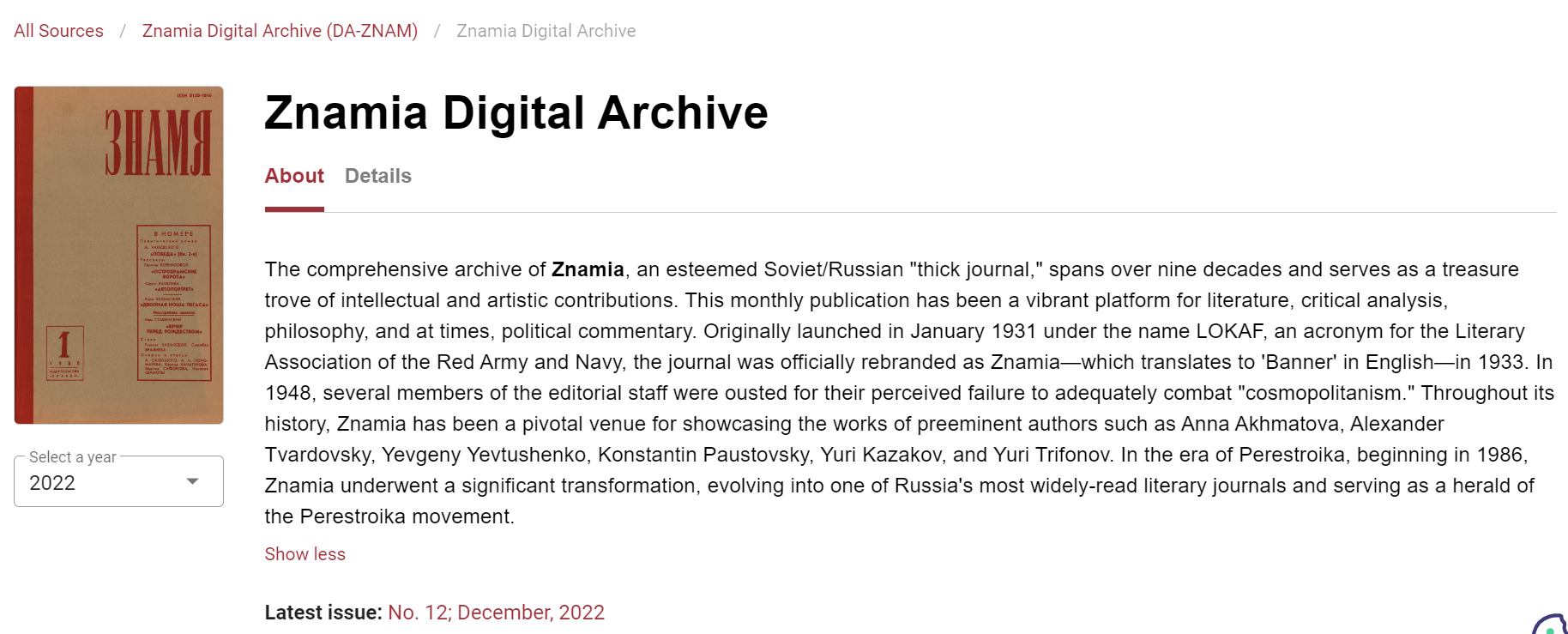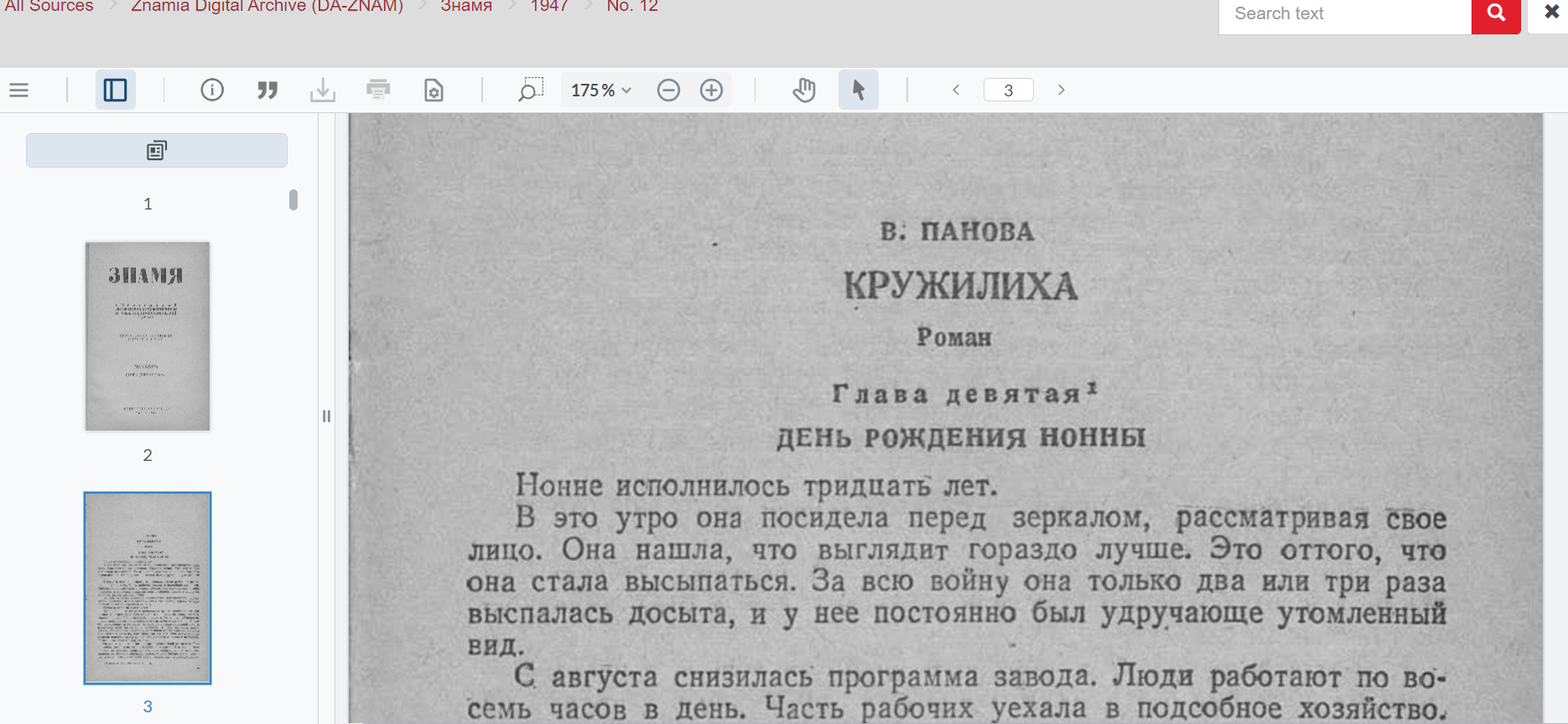Tag: Russian Literature
Library Trial: Znamia Digital Archive (Soviet-era periodical)
At the library, we have set up a thirty-day trial of Znamia Digital Archive through November 18, 2023.
The extensive archive of Znamia (Знамя, Banner), a highly regarded Soviet/Russian “thick journal” (tolstyi zhurnal), covers more than nine decades and is a rich source of intellectual and artistic contributions. This monthly publication has been a vibrant platform for literature, critical analysis, philosophy, and, at times, political commentary.
Originally introduced in January 1931 as LOKAF (Локаф), an acronym for the Literary Association of the Red Army and Navy, the journal officially adopted the name Znamia, which translates to “Banner” in English, in 1933. Throughout its history, Znamia has played a crucial role in presenting the works of renowned authors such as Anna Akhmatova, Alexander Tvardovsky, Yevgeny Yevtushenko, Konstantin Paustovsky, Yuri Kazakov, and Yuri Trifonov.
During the era of Perestroika, starting in 1986, Znamia underwent a significant transformation and became one of Russia’s most widely read literary journals, serving as a herald of the Perestroika movement.


Access Link: https://libproxy.berkeley.edu/login?qurl=https%3A%2F%2Fdlib.eastview.com%2Fbrowse%2Fudb%2F6250
Call for Papers: Russian Literature’s Cluster on Contagion and Conflagration
CfP: Russian Literature’s Cluster on Contagion and Conflagration
Abstract deadline: February 1, 2021; Abstract length: 300 words
“During the war people avidly read Tolstoy’s War and Peace as a means of testing their reactions.” So begins Lydia Ginzburg’s The Siege of Leningrad: Notes of a Survivor. Now that the very fiber of our social life has been upended by the pandemic, whose reverberations will be undoubtedly with us for many years to come, the journal Russian Literature proposes to again turn to books for insights on our common predicament. In the Petersburg of Osip Mandelstam’s The Egyptian Stamp, library books “are inhabited by measles, scarlatina, and chicken pox.” Indeed, classics of Russian and East European literature are swarming with infection, and more often than not contagion mixes with political conflagration in their fevered collective consciousness. And, even before the era of Covid-19, contemporary literature and film became infested with scenarios in which viruses, both biological and digital, are unleashed, either intentionally or accidentally, by either the West or the East upon the world with catastrophic consequences.
These narratives offer an effective prism for the exploration and analysis of mechanisms through which our fears of contamination are turned into practices of othering, so familiar to us from our current daily lives. Literary encounters with deadly pathogens also offer us a chance to ponder posthumanist and environmental concerns: as the virus challenges anthropocentrism (i.e., human supremacy, exceptionalism, and control), humans are forced to renegotiate their relationships with their nonhuman others as well as to consider the role of chance and contingency in human life. The cluster of articles will make a sustained scholarly effort to examine outbreak narratives and metaphors of infection and understand the cultural politics of contagion in Russia and Eastern Europe. Comparativist perspectives are welcome.
The themes we propose to explore are:
–historical outbreaks and their literary representation –imaginary outbreaks, catastrophic visions of the future, and dystopian imaginaries –expression of contemporary anxieties and traumas through metaphors of infection and contamination –aesthetic categories involved in our thinking about infection: communication, transmission, circulation, contact, distance –relationship between protagonists’ diseases and their political affiliations –potency of pathogens and the critique of reason –discourses of infection and the role of chance and contingency in human life –infectious outbreaks, cross-species transmission, and ecological catastrophes –literary and cinematic reflections on the regimes of biopolitics and bioethics –metaphors of infection, rhetoric of invasive species and viral mutation, and fears of foreign adulteration –art as infection: viral circulation of ideas and feelings –cross-contamination between the viral spread of information and the transmission of the disease –affective intensities associated with epidemics, separation, contamination, social rupture, and death –relationship between physical health and morals, ideas, emotions
Please send your abstracts to the cluster’s editor, Julia Vaingurt at vaingurt@uic.edu.
Article deadline: August 1, 2021
Posted on behalf of a colleague at the University of Illinois at Chicago.